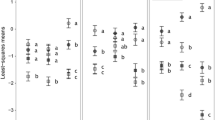Abstract
The convict cichlid, Amatitlania siquia, is a serially monogamous, bi-parental cichlid species native to Costa Rican rivers. Numerous field studies conducted in the Rio Cabuyo (Lomas Barbudal, Costa Rica) have provided a wealth of information regarding the behavioral ecology of this species. Recently a cichlid species that was previously not found in the Rio Cabuyo was identified as Hypsophrys nematopus. This influx of this non-native species provides an interesting ability to study the interactions of this potentially invasive species and to monitor the changes made by the native cichlid species. Over the course of several field seasons, I investigated the interactions between the native convict cichlid and the non-native cichlid. I surveyed the distribution of breeding pairs of both species and conducted behavioral tests to examine the interactions between the native and non-native species. I found an overall decline breeding pairs of both species over the course of the study. I found that both species were more aggressive to conspecific intruders and that female convict cichlids were aggressive to juveniles but males were not. These results provide important information concerning how native species interact with non-native species. It appears that the A. siquia population may experience a change in its reproductive behaviors due to the influx of H. nematopus.




Similar content being viewed by others
References
Bussing WA (1998) Freshwater fishes of Costa Rica. Second edition. San Jose
Garcia-Berthou E (2007) The characteristics of invasive fishes: what has been learned so far? J Fish Biol 71:33–55
Gherardi F, Robert Britton J, Mavuti KM, Pacini N, Grey J, Tricarico E, Harper DM (2011) A review of allo diversity in Lake Naivasha, Kenya: Developing conservation actions to protect East African lakes from the negative impacts of alien species. Biol Conserv 144:2585–2596
Gozlan RE (2008) Introduction of non-native freshwater fish: is it all bad? Fish 9:106–115
Gumm JM, Itzkowitz M (2007) Pair-bond formation and breeding-site limitation in the convict cichlid, Archocentrus nigrofasciatus. Acta Ethol 10:29–33
Itzkowitz M, Haley M (1999) Are males with more attractive resources more selective in their mate preferences? a test in a polygynous species. Behav Ecol 10:366–371
Itzkowitz M, Makie D (1986) Habitat structure and reproductive success in the beaugregory damselfish. J Exp Mar Biol Ecol 97:305–312
Jaric I, Cvijanovic G (2012) The tens rule in invasion biology: measure of a true impact or our lack of knowledge and understanding? Environ Manag 50:979–981
Lehtonen TK (2008) Convict cichlids benefit from close proximity to another species of cichlid fish. Biol Lett 4:610–612
Lehtonen TK, Lindstrom K (2008) Density-dependent sexual selection in the monogamous fish Archocentrus nigrofasciatus. Oikos 117:867–874
Lehtonen TK, Wong BBM, Lindstrom K, Meyer A (2011) Species divergence and seasonal succession in rates of mate desertion in closely related Neotropical cichlid fishes. Behav Ecol Sociobiol 65:607–612
Lehtonen TK, McCrary JK, Meyer A (2012) Introduced Predator Elicits Deficient Brood Defence Behaviour in a Crater Lake Fish. PLoS One 7
Leprieur F, Brosse S, García-Berthou E, Oberdorff T, Olden JD, Townsend CR (2009) Scientific uncertainty and the assessment of risks posed by non-native freshwater fishes. Fish 10:88–97
Mackereth RW, Keenleyside MHA (1993) Breeding territoriality and pair formation in the convict cichlid (Cichlasoma nigrofasciatum - Pisces, Cichlidae). Can J Zool 71:960–967
Martin CW, Valentine MM, Valentine JF (2010) Competitive Interactions between Invasive Nile Tilapia and Native Fish: The Potential for Altered Trophic Exchange and Modification of Food Webs. PLoS One 5
McKaye KR (1977) Competition for breeding sited between the cichlids of Lake Jiloa, Nicaragua. Ecology 58:291–302
McKaye KR, Hale J, van den Berghe EP (2010) The reproductive biology of a Central American cichlid Neetroplus nematopus in Lake Xiloa. Nicaragua Curr Zool 56:43–51
Sanches, FH, Miyai, CA, Costa, TM, Christofoletti, RA, Volpato, GL, Barreto, RE (2012) Aggressiveness Overcomes Body-Size Effects in Fights Staged between Invasive and Native Fish Species with Overlapping Niches. PLoS One 7
Schmitter-Soto JJ (2007) A systematic revision of the genus Archocentrus (Perciformes : Cichlidae), with the description of two new genera and six new species. Zootaxa: 3–76
Sharpe DMT, Wandera SB, Chapman LJ (2012) Life history change in response to fishing and an introduced predator in the East African cyprinid Rastrineobola argentea. Evol Appl 5:677–693
Snekser JL, Leese J, Ganim A, Itzkowitz M (2008) Caribbean damselfish with varying territory quality: correlated behaviors but not a syndrome. Behav Ecol 20:124–130
Valero A, Macías Garcia C, Magurran AE (2008) Heterospecific harassment of native endangered fishes by invasive guppies in Mexico. Biol Lett 4:149–152
van Breukelen NA (2004) A field investigation of parental care and aggressive behavior in the convict cichlid. Lehigh University, Bethlehem
van Breukelen NA, Itzkowitz M (2011) Mate removal leads to increase in parental defence behaviour in free-ranging convict cichlids. Anim Behav 82:1023–1026
Watanabe WO, Losordo TM, Fitzsimmons K, Hanley F (2002) Tilapia production systems in the Americas: technological advances, trends, and challenges. Rev Fish Sci 10:465–498
Wisenden BD (1994) Factors affecting reproductive success in free-ranging convict cichlids (Cichlasoma nigrofasciatum). Can J Zool 72:2177–2185
Wisenden BD (1995) Reproductive behavior of free-ranging convict cichlids, Cichlasoma nigrofasciatum. Environ Biol Fish 43:121–134
Wisenden BD, Snekser JL, Stumbo AD, Leese JM (2008) Parental defence of an empty nest after catastrophic brood loss. Anim Behav 76:2059–2067
Acknowledgements
The author wishes to acknowledge the assistance of undergraduate students L. Mock (2009), C. Sawyer (2010) and K. Rose (2012). The pair distribution data was collected in 2011 by A. Robart (UC Santa Cruz). All research was conducted with the approval of MINAE and SINAC and with financial support from Mount Aloysius College. This work was supported by an award from the Guy Jordan Endowment Fund of the American Cichlid Association.
Author information
Authors and Affiliations
Corresponding author
Rights and permissions
About this article
Cite this article
van Breukelen, N.A. Interactions between native and non-native cichlid species in a Costa Rican river. Environ Biol Fish 98, 885–889 (2015). https://doi.org/10.1007/s10641-014-0322-z
Received:
Accepted:
Published:
Issue Date:
DOI: https://doi.org/10.1007/s10641-014-0322-z




